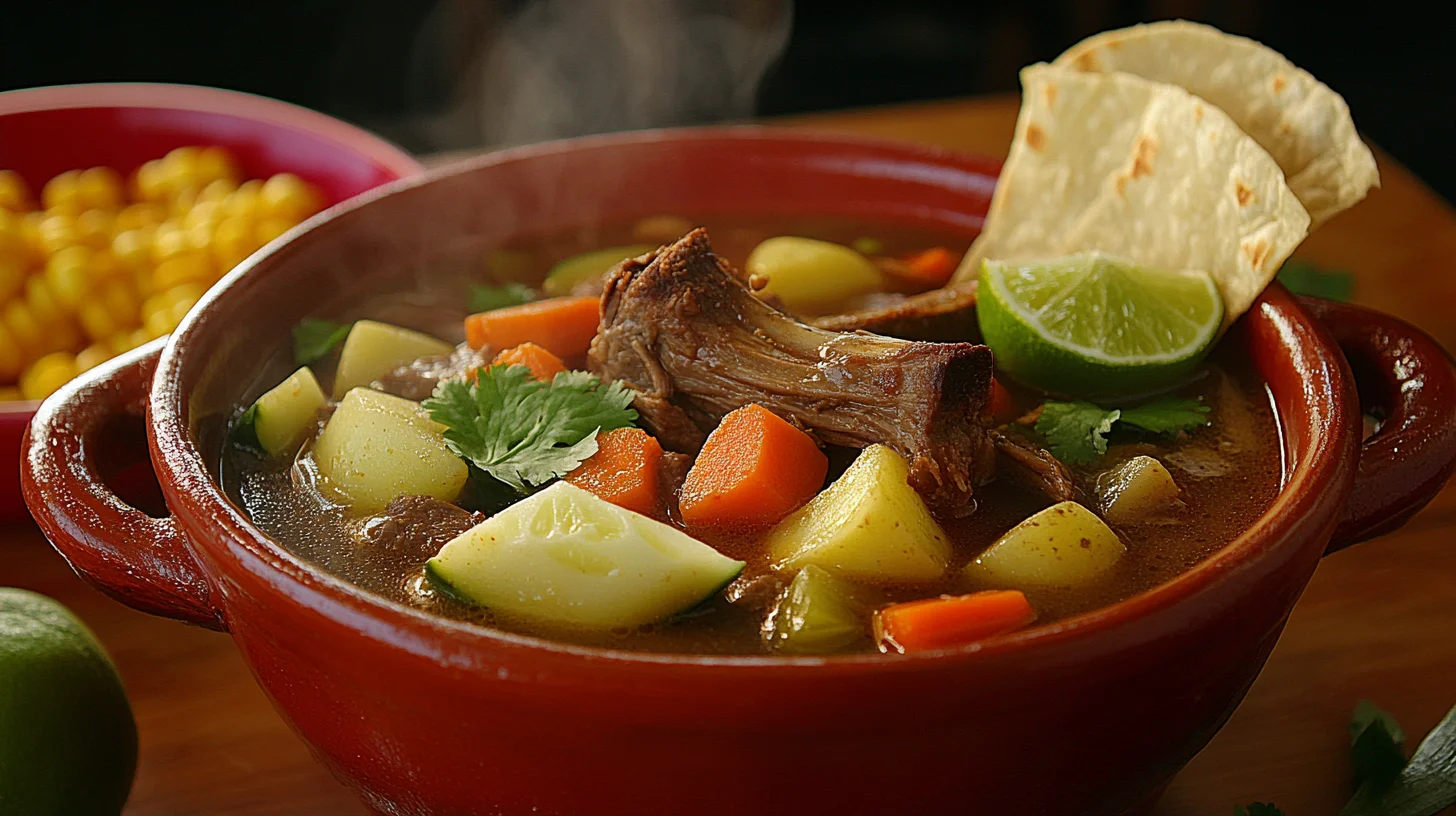What is Caldo de Res?
The Definition of Caldo de Res
Caldo de Res, or “beef soup,” is a quintessential Mexican dish loved for its robust flavors and nourishing ingredients. Featuring tender, bone-in beef cuts, fresh vegetables like corn, squash, and carrots, and a fragrant blend of herbs, this soup offers warmth and comfort in every spoonful. Traditionally served piping hot, Caldo de Res is a beloved staple during cooler months or whenever a soul-satisfying meal is needed.
This rustic dish is presented with simplicity yet elegance, often accompanied by lime wedges, warm tortillas, and, for those who crave a touch of heat, a side of salsa. Its combination of rich broth and hearty vegetables makes it as nutrient-packed as it is flavorful.
For those who love exploring diverse comfort foods, you might also enjoy discovering the Corn Pudding Recipe: The Ultimate Guide to a Perfectly Irresistible Dish. This sweet and savory dish pairs perfectly with many hearty meals like Caldo de Res, adding a delightful twist to your culinary experience.
Traditional Ingredients in Caldo de Res
The beauty of Caldo de Res lies in its simplicity. The traditional recipe calls for:
- Bone-in beef shanks: These provide both tender meat and rich marrow that enhances the broth’s flavor.
- Fresh vegetables: Common additions include corn on the cob, carrots, zucchini, potatoes, and cabbage.
- Herbs and spices: Cilantro, garlic, onion, and a touch of salt and pepper are the key seasonings.
While the recipe can vary by region or personal preference, these ingredients form the base of this iconic dish. The combination of beef, vegetables, and spices creates a warm, savory broth that’s a delight to the senses.
Stay tuned as we explore the origins, benefits, and variations of this classic Mexican soup!
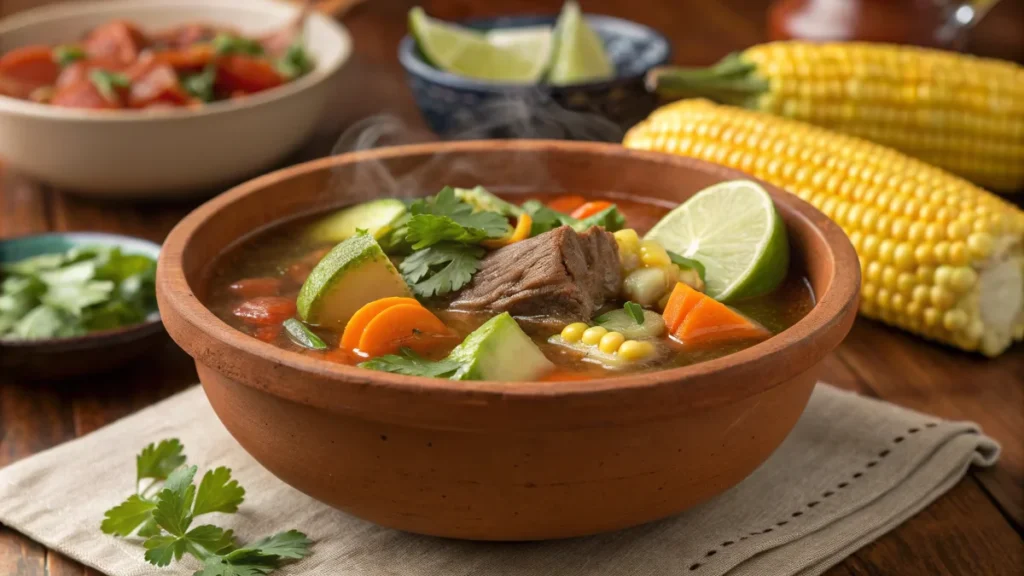
Table of Contents
PART 2: The History and Origin of Caldo de Res (350 words)
Where Caldo de Res Comes From
Caldo de Res has deep roots in Mexican culinary history, dating back to centuries-old traditions of slow-cooking meals to extract maximum flavor and nutrition. The dish emerged as a staple in Mexican households, particularly in rural areas where families used simple, locally sourced ingredients.
The origins of Caldo de Res are closely tied to Mexico’s agricultural heritage. Beef, which became widely available after Spanish colonization, became a popular protein for hearty meals. Paired with an abundance of fresh vegetables grown in Mexican farms, Caldo de Res evolved into a dish that not only nourished the body but also symbolized the connection between the land and the kitchen.
The Cultural Significance of Caldo de Res
This dish is much more than just a meal; it represents comfort, community, and tradition. Caldo de Res is often served during family gatherings, celebrations, or simply as a way to show care and love for loved ones. Its warming, nutrient-rich properties also make it a common remedy for colds, hangovers, or even emotional comfort after a tough day.
In many regions of Mexico, families pass down their Caldo de Res recipes through generations, adding unique touches that reflect local flavors. For example, some families include chayote (a type of squash), while others add spicy chilies for an extra kick.
Caldo de Res Beyond Mexico
Although Caldo de Res is a traditional Mexican dish, variations of beef soups with vegetables can be found across the globe. In neighboring Central American countries, for example, similar hearty soups are enjoyed under different names and slight ingredient tweaks. However, what sets Caldo de Res apart is its uniquely Mexican essence—highlighted by traditional preparation methods and signature ingredients such as fresh cilantro, lime, and bone-in beef.
This dish is more than just a meal; it’s a gathering point that brings people together, offering a blend of history, culture, and flavor in every bowl. The versatility and heartiness of Caldo de Res make it a beloved staple in Mexican households and beyond.
For an equally comforting side dish to pair with your Caldo de Res, consider the Corn Pudding Recipe: The Ultimate Guide to a Perfectly Irresistible Dish. Its sweet and savory profile complements the rich and vibrant flavors of this iconic soup, making it a delightful addition to your table.
The Step-by-Step Recipe for Caldo de Res
Ingredients Needed for Caldo de Res
To prepare this hearty and traditional dish, you’ll need the following ingredients:
- 2 lbs bone-in beef shanks: The marrow in the bones enriches the broth’s flavor.
- 2 ears of corn: Cut into halves or thirds for easy serving.
- 2 carrots: Peeled and chopped into thick slices.
- 2 potatoes: Peeled and cubed for texture.
- 1 zucchini: Sliced into rounds for added freshness.
- 1 medium cabbage: Cut into wedges.
- 1 medium onion: Halved, for flavoring the broth.
- 3 garlic cloves: Crushed or minced.
- Fresh cilantro: A handful to add flavor and garnish.
- Salt and pepper: To taste.
- 12 cups of water: For the broth.
- Lime wedges: For serving.
- Warm tortillas: Optional, but traditional as a side.
Cooking Instructions for Caldo de Res
Step 1: Preparing the Beef
- In a large pot, place the beef shanks and cover them with the 12 cups of water.
- Bring the water to a boil, then reduce the heat to medium-low. Skim off any foam that rises to the surface.
- Add the onion, garlic, and a pinch of salt. Cover and let the beef simmer for about 1 hour or until it becomes tender.
Step 2: Adding Vegetables
- Once the beef is tender, add the corn, carrots, and potatoes to the pot. Simmer for 15 minutes to allow the vegetables to soften.
- Next, add the zucchini and cabbage. Continue cooking for an additional 10-15 minutes until all the vegetables are cooked through but not mushy.
Step 3: Seasoning and Serving
- Taste the broth and adjust the seasoning with salt and pepper as needed.
- Stir in chopped fresh cilantro for added flavor.
Step 4: Serving Suggestions
- Serve Caldo de Res hot in large bowls, ensuring each serving has a generous portion of meat, vegetables, and broth.
- Garnish with lime wedges and offer warm tortillas on the side for dipping.
Pro Tips for Perfect Caldo de Res
- Use Fresh Ingredients: The flavor of Caldo de Res depends heavily on the freshness of its ingredients.
- Low and Slow Cooking: Simmering the beef over low heat allows the flavors to meld and the meat to become tender.
- Customizable Vegetables: You can add chayote, green beans, or any seasonal vegetables for a personal touch.
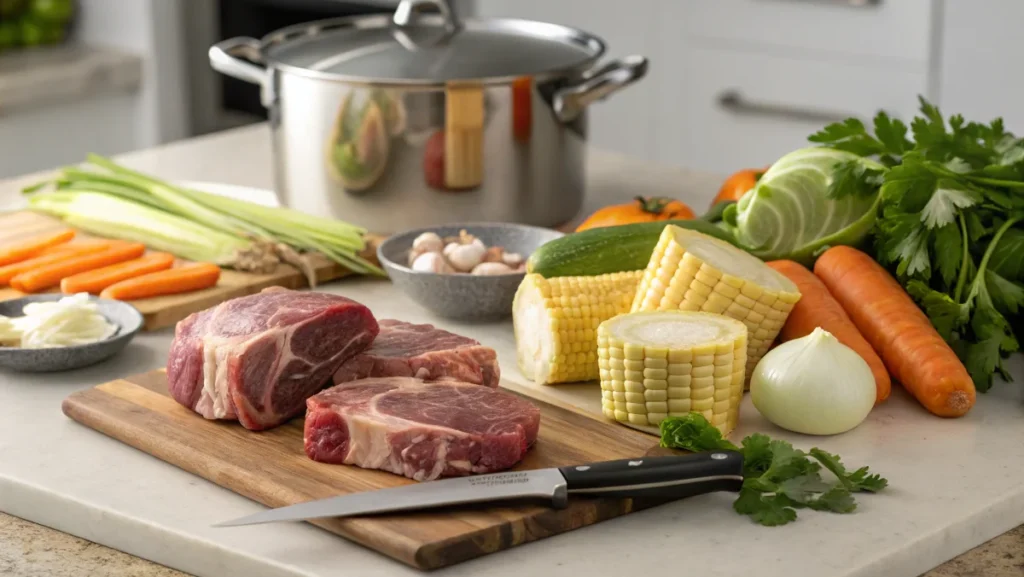
Nutritional Benefits of Caldo de Res
Is Caldo de Res Healthy?
Yes, Caldo de Res is not only comforting but also highly nutritious, making it a popular choice for those seeking a wholesome and hearty meal. Packed with protein, vitamins, and minerals, it delivers essential nutrients in every serving.
Key Nutritional Benefits:
- Rich in Protein: The beef shanks provide a significant source of high-quality protein, which supports muscle repair, immune function, and overall energy levels.
- Vitamins from Vegetables: Ingredients like carrots, zucchini, and cabbage are loaded with vitamins such as Vitamin A (for eye health), Vitamin C (for immunity), and Vitamin K (for bone health).
- Mineral Boost: The bone-in beef shanks release minerals like calcium, magnesium, and phosphorus into the broth, contributing to strong bones and teeth.
- Low in Calories: Despite being filling, Caldo de Res is relatively low in calories, especially when prepared with lean cuts of beef and minimal oil.
Low-Calorie Options for Caldo de Res
For those who want to enjoy a lighter version, here are some tips to reduce the calorie count without sacrificing flavor:
- Use Lean Cuts of Beef: Swap out beef shanks for leaner options like sirloin or round cuts.
- Go Easy on the Salt: Limit the sodium by seasoning with fresh herbs and a squeeze of lime for natural flavor.
- Add More Vegetables: Bulk up the soup with low-calorie vegetables like spinach, green beans, or broccoli.
The Perfect Comfort Food
Thanks to its balanced mix of proteins, carbs, and healthy fats, Caldo de Res is an ideal meal to replenish your body after a long day. It’s also a great option for recovering from illness due to its hydrating broth and immune-boosting nutrients.
How to Serve and Eat Caldo de Res
How to Eat Caldo de Res
Caldo de Res is more than just a soup—it’s an experience! To enjoy it properly, follow these simple steps:
- Break Apart the Beef: Use a fork to shred the tender beef from the bone, ensuring every bite is infused with the broth’s rich flavor.
- Savor the Broth: Sip the hot broth first to warm up your palate and appreciate its savory taste.
- Combine with Sides: Add a squeeze of lime juice, fresh cilantro, or a spoonful of salsa for an extra kick. Pair it with warm corn tortillas to soak up the flavorful broth or create mini tacos using the shredded beef and vegetables.
Pairing Suggestions with Caldo de Res
Caldo de Res is incredibly versatile and can be served with various accompaniments to elevate the meal. Here are a few traditional pairings:
- Corn Tortillas: Freshly made tortillas are perfect for dipping or wrapping around the beef.
- Mexican Rice: A small bowl of seasoned rice can complement the soup and make it even more filling.
- Lime and Salsa: Add freshness and a bit of spice by serving lime wedges and your favorite salsa on the side.
- Aguas Frescas: Refreshing beverages like horchata, tamarind agua fresca, or Jamaica tea are traditional drinks that balance the warmth of the soup.
The Perfect Meal for Any Occasion
Whether enjoyed as a standalone meal or as part of a larger feast, Caldo de Res is a dish that brings people together. Its hearty portions and fresh flavors make it ideal for family dinners, special celebrations, or even a comforting lunch on a cold day.
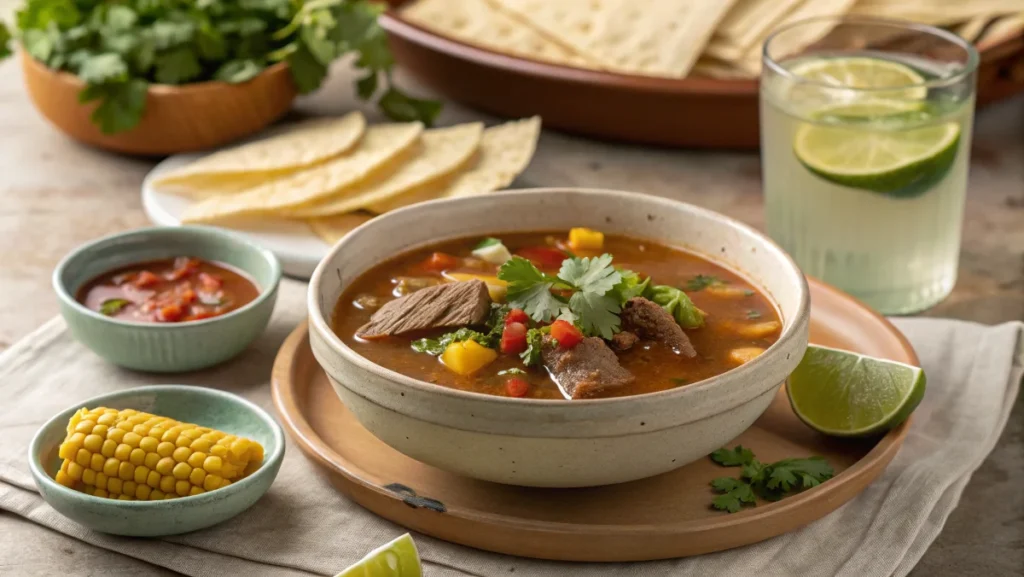
How to Store and Reheat Caldo de Res
How Long Can Caldo de Res Be Stored in the Refrigerator?
Caldo de Res can be safely stored in the refrigerator for up to 4 days. To ensure freshness and prevent spoilage, follow these steps:
- Cool It Down: Allow the soup to cool to room temperature before storing it. This prevents condensation, which can lead to bacterial growth.
- Use Airtight Containers: Transfer the soup into airtight containers to keep it fresh and prevent odors from affecting the flavor.
- Label and Date: Write the date on the container to track how long it’s been stored.
If you need to keep Caldo de Res for longer, freezing is a great option. The soup can be frozen for up to 3 months.
Best Methods to Reheat Caldo de Res
When reheating Caldo de Res, it’s essential to preserve its texture and flavor. Here are the best methods:
1. On the Stovetop (Best Option)
- Pour the soup into a pot and heat it over medium heat.
- Stir occasionally to prevent sticking and ensure even heating.
- Heat until the broth is steaming and the vegetables are warmed through (about 10-15 minutes).
2. In the Microwave (Quick Option)
- Place a portion of the soup in a microwave-safe bowl.
- Cover it loosely with a microwave-safe lid to prevent splatters.
- Heat on high for 2-3 minutes, stirring halfway through to ensure even heating.
3. Thawing Frozen Caldo de Res
- To reheat frozen Caldo de Res, allow it to thaw in the refrigerator overnight before reheating on the stovetop or in the microwave.
Pro Tip for Leftovers
When reheating, consider adding a splash of fresh lime juice or a sprinkle of cilantro to revive the flavors of the soup. Pair it with warm tortillas to enjoy it just like the first day!
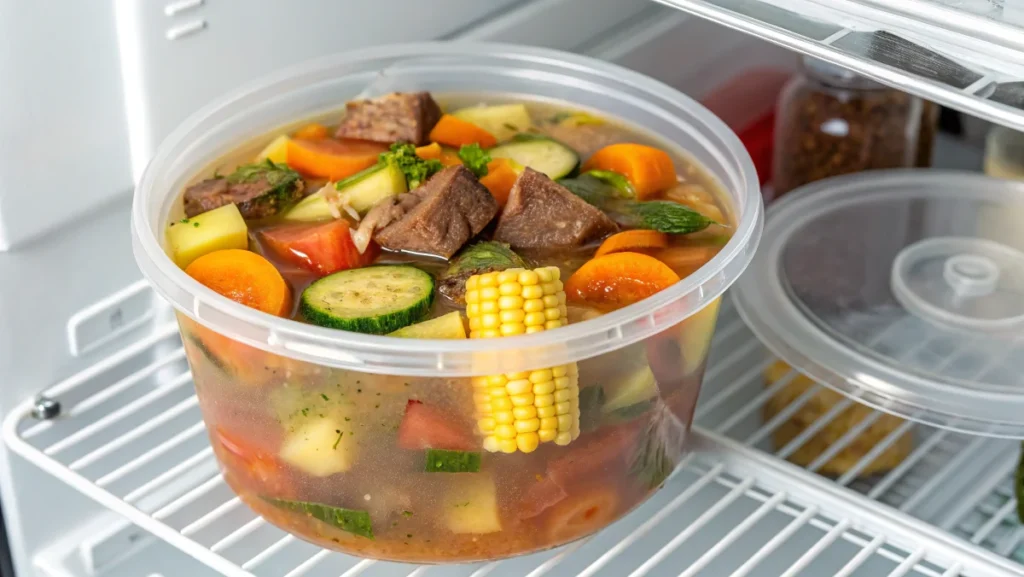
Variations of Caldo de Res Around the World
Regional Mexican Variations
Caldo de Res may have its roots in Mexico, but the dish varies significantly across the country, influenced by regional ingredients and culinary traditions.
1. Northern Mexico
In northern states like Nuevo León or Chihuahua, Caldo de Res often includes poblano peppers or green chilies, giving the dish a spicy kick. Additionally, some recipes use rice instead of potatoes for a unique twist.
2. Central Mexico
The central regions stick closely to the classic recipe but sometimes add chayote, a type of squash, or epazote, a fragrant herb that enhances the broth’s depth of flavor.
3. Southern Mexico
In the south, where tropical climates dominate, cooks frequently add plantains or yucca to the soup, creating a slightly sweeter, heartier variation.
Caldo de Res in Other Cultures
While Caldo de Res is quintessentially Mexican, its comforting combination of beef, broth, and vegetables is a concept shared by many cuisines worldwide.
1. Colombian Sancocho
Colombian Sancocho de Res is a close cousin to Caldo de Res. It includes beef, yucca, plantains, and corn, creating a rich and slightly sweet broth. It’s also traditionally served with rice and avocado on the side.
2. Vietnamese Pho
Vietnam’s Pho Bo (beef noodle soup) shares similarities with Caldo de Res. It uses beef bones to create a rich broth, enhanced by herbs like cilantro and basil. However, it features rice noodles and bold spices like star anise and cinnamon.
3. Filipino Bulalo
The Philippines’ Bulalo is another variation of beef soup that uses bone-in beef shanks. The broth is often enriched with cabbage, corn, and green beans, offering a taste and texture similar to Caldo de Res.
Why These Variations Matter
The many variations of beef-based soups reflect the adaptability of simple ingredients like beef and vegetables. Across cultures, these dishes symbolize warmth, comfort, and nourishment, bringing people together around the dinner table.
Common Mistakes to Avoid When Cooking Caldo de Res
1. Overcooking the Beef
One of the most common mistakes when making Caldo de Res is overcooking the beef. While it’s important to cook the beef long enough to tenderize it, leaving it on the stove for too long can cause it to lose its texture and flavor.
Pro Tip: Simmer the beef on low heat until tender (around 1.5 to 2 hours), but keep an eye on it. Use a fork to check its doneness before adding vegetables.
2. Adding Vegetables Too Early
Vegetables like zucchini and cabbage cook much faster than beef or potatoes. Adding them at the start of cooking can result in mushy, overcooked veggies that lose their texture and flavor.
Pro Tip: Add heartier vegetables like potatoes and carrots first, and wait until the last 10-15 minutes of cooking to toss in softer vegetables like zucchini and cabbage.
3. Skipping Fresh Herbs and Spices
The flavor of Caldo de Res largely depends on the freshness of its herbs and spices. Skipping fresh cilantro or relying only on salt can result in a bland broth.
Pro Tip: Always include fresh cilantro and lime to enhance the soup’s brightness. You can also add garlic and onion for a deeper flavor profile.
4. Not Skimming the Foam from the Broth
When cooking beef, foam or impurities often rise to the top of the broth. Failing to skim this off can result in a cloudy soup and affect the final taste.
Pro Tip: Use a ladle to remove foam during the first 20-30 minutes of simmering. This keeps your broth clear and clean.
5. Using Low-Quality Meat
The richness of the broth depends on the quality of the beef. Using low-grade meat can lead to a bland, less flavorful dish.
Pro Tip: Opt for bone-in beef shanks from a trusted butcher or local market. Bones add depth and richness to the broth.
Frequently Asked Questions About Caldo de Res
1. How to Eat Caldo de Res?
Caldo de Res is best enjoyed as a complete, hearty meal. Here’s how to make the most of it:
- Break the tender beef shanks apart using a fork and mix them with the vegetables in your bowl.
- Add a squeeze of fresh lime juice to brighten the flavors.
- Pair the soup with warm corn tortillas, dipping them into the broth or using them to make mini tacos with the shredded beef.
- For a spicier kick, add a dollop of salsa or diced jalapeños.
2. What is the Origin of Caldo de Res?
Caldo de Res is a traditional Mexican dish with origins rooted in the country’s rural farming communities. It was created as a way to make use of simple, readily available ingredients such as beef, fresh vegetables, and herbs. Over time, it became a beloved comfort food, often served during family meals and celebrations.
3. Is Caldo de Res Healthy?
Absolutely! Caldo de Res is both nutritious and filling. Here’s why:
- It’s high in protein, thanks to the beef shanks, which help repair and build muscles.
- Vegetables like carrots, zucchini, and cabbage provide essential vitamins and minerals, supporting immunity and overall health.
- The broth is hydrating and easy to digest, making it perfect for recovery from illness.
For a lighter version, opt for leaner cuts of beef and reduce the salt content.
4. How Long Can Caldo de Res Be Stored in the Refrigerator?
Caldo de Res can be stored in the refrigerator for up to 4 days in an airtight container. If you wish to keep it longer, freezing is a great option—it stays fresh in the freezer for up to 3 months. Make sure to reheat it properly on the stove or in the microwave before serving.
Conclusion: Why Caldo de Res is a Must-Try Dish
Caldo de Res is more than just soup; it’s a delicious journey into Mexican culinary heritage. Made with a rich broth, tender beef, and fresh vegetables, it’s a perfect mix of flavor, nutrition, and comfort. Whether for a family dinner or to warm up on a cold day, this timeless dish always satisfies.
Its rustic origins add authenticity, while its versatility lets you customize with your favorite vegetables and spices. Packed with protein and vitamins, Caldo de Res is as healthy as it is flavorful.
For another cozy meal, try this Tomato Bisque Soup Recipe. Its creamy, rich taste pairs beautifully with the comforting simplicity of Caldo de Res.

